Article - RareWine Academy
Krug Champagne - The Story Of A Complete Symphony Orchestra And Inherited Perfect Champagne Spirit
Krug is among the best champagne houses in the world, maybe the best! How did they become so good? Find out as Krug Champagne is described decade by decade - wine by wine.
“The Krug Moment should always be about pleasure”
- Oliver Krug
Music in a bottle. Quality. Expertise. These associations accompany Krug, which today is considered among the world's absolute best Champagne producers. Through years of experience and innovation, Krug has created Champagnes in sweet symphony. At the front is Oliver Krug, and before him, other competent family members who devoted their lives to the bubbly wine. Fortunately. This is the story of the famous Krug.
Krug Arrives In Champagne
The Champagne house Krug was founded in Reims in 1843 by Joseph Krug - born in Mainz and son of a butcher. He left his hometown in 1824 in search of adventure, which brought him to Paris in 1834. He came to Champagne as a bookkeeper for the Champagne house Jacquesson. During the next eight years, he moved around many corners of the Champagne house, learning everything from sales to mixing Champagne in the cellar. He proved so skilled at blending that by 1840 he was assisting in blending Champagne for other houses. Therefore, it was not surprising that he wanted to start his own Champagne house, which fortunately became a reality.
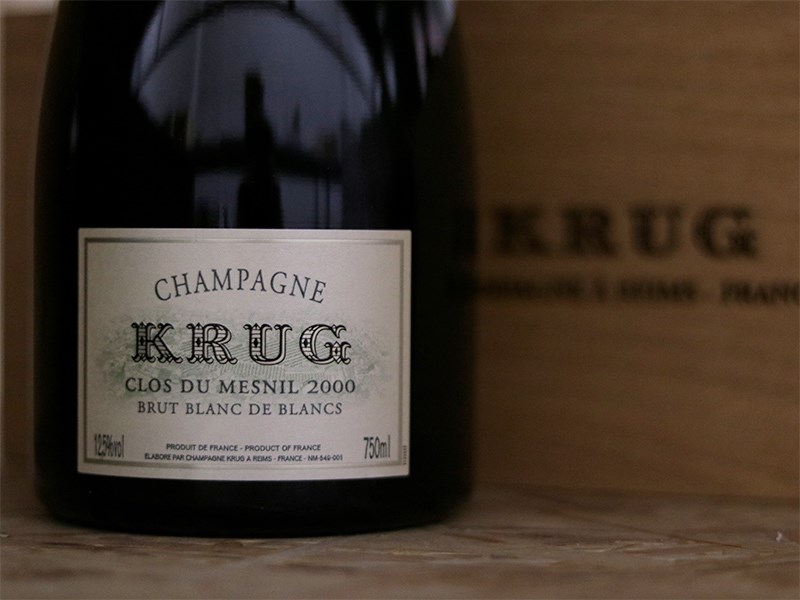
Krug Is A Family Business Rooted In Unquestionable Quality
Paul Krug was Joseph's son, who took over the helm upon his father's death in 1866. Under Paul's leadership, the house became part of the association of the great Champagne houses, the grand marquee. It moved its base to its present address in Reims. Paul reigned until he died in 1910, and his son Joseph Krug II continued the baton. Joseph steered the house through World War I. Unfortunately, he was taken prisoner and returned ill to the estate after the war. His nephew Jean Seydoux became part of the management. During this period, two of the most excellent wines were produced at Krug: The 1926 and 1928 vintages, which still stand as luminaries of the greatness of this period at Krug.
In 1962 and 1965, the two brothers Henri and Remi joined the company's management and started to expand the activities further. The first rosé came on the market during this period, and several good vineyards were acquired. In 1971, a handful of vineyards in and around Mesnil-sur-Oger were bought. Among those was the famous Clos du Mesnil, which later became the house's first single-vineyard Champagne. In 1979, they hired an outside winemaker for the first time to handle the vital process of blending the base wines in the cellar.
Over generations, the Krug family has maintained a consistently high standard and sublime management. Quality is always the ultimate goal, but good and close relations with other producers in Champagne have also been a priority for Krug. These priorities still hold true, even if the ownership of Krug has changed hands.
Krug With New Ownership, But The Same Quality-Assured Champagne Spirit
In 1999, the world's most substantial luxury goods group LVMH (Louis Vuitton Moet Hennesy), took ownership of Krug. Still, they deliberately kept the Krug family close. It is the family spirit that has driven Krug. Therefore, the family still leads the company in the right direction. Until 2007, Krug was run by the two brothers Remi and Henri. They remained part of the tasting committee, which annually tastes and assesses the production and its components at Krug.
Since 2009, Henri's son Olivier Krug has been the director of Krug. The advantage of having a group like LVMH along is a more massive and uncompromising approach to quality as a pillar. Furthermore, a large corporation also provides massive marketing forces and very professional distribution of the house's famous Champagne.
LVMH is not entirely unknown in Champagne, owning 16 different estates. However, there is no doubt that Krug is the diamond in their collection. In addition to interests in Champagne, they are also involved in significant wine estates such as Château Cheval-Blanc, Château d'Yquem, Clos de Lambrays, and Newton Vineyards. Also, they have a strong presence with Glenmorangie, Belvedere, and Ardbeg in the spirits business.
Most importantly, LMVH is not trying to make Krug or other estates their own. They are building on what Krug already created - and that is the family with the strong Champagne spirit.
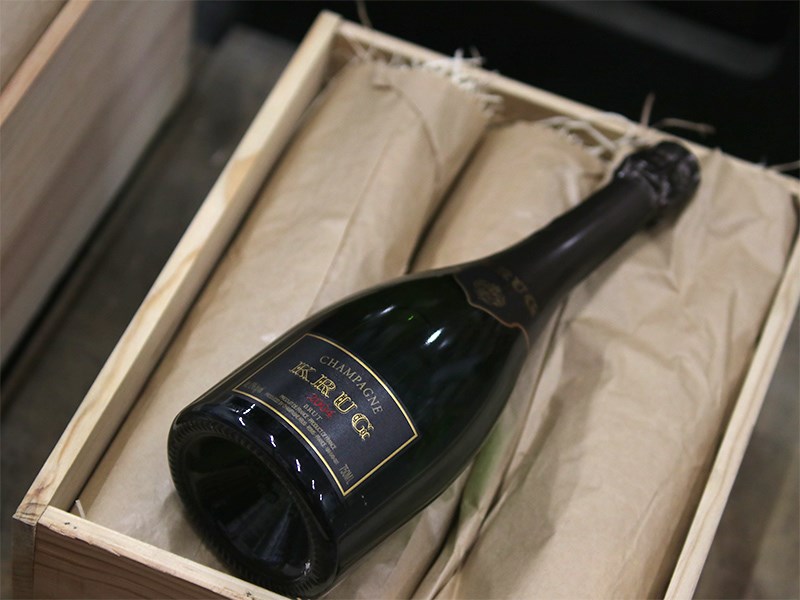
The Production Of Krug Champagne
Like most other Champagne houses, Krug does not own all the vineyards that supply grapes for their production. They own about 30%, which is typical for the great Champagne houses. Of course, they have long-term contracts with the farmers who grow the grapes, and thus they are assured of continuous high quality of raw material.
In total, Krug has access to grapes from around 400 different parcels. Each lot is vinified separately. The fermentation takes place in small 205-liter oak barrels between 4 and 40 years old. This is not done to add barrel flavor to the wine but to undergo a slight oxidation during fermentation, which adds further complexity to the final product. The wine remains in the barrels until the end of the year when it is transferred to steel tanks. Afterward, the first tasting by the tasting committee takes place.
At Krug, the wine does not undergo malolactic conversion as this reduces the overall acidity level. At Krug, they want the high natural acidity of the wine to create an even better development process for each bottle.
Krugs Essential Taste Comite
At Krug, the tasting committee is a group of five people headed by Olivier Krug and cellar master Julie Cavil. In the months after production, they assess the year's individual components and older vintages from the warehouse. The latter is called reserve wine. It helps create continuity and balance in the final version of Grande Cuvée and Rosé, composed of several vintages.
There is no denying the complexity of this process. A cellar master must be 'trained' over several decades, working alongside the former master. Julie Cavil has done this with Eric Lebel. He made 22 versions of Grande Cuvée before passing the baton to Julie. There is no measuring or calculating what goes into a blend - that is determined by smell and tasting by a trained nose and palate.
After blending, the bottles are cellared at Krug (for at least six years for Grande Cuvée) before receiving their final cork and label. Since 2011, Krug has developed the Krug Lovers Universe, where you can find details about each bottle. On the back of each bottle is a number, which can be entered on Krug's website or app, and precise information about the grape composition, vintages, and villages of the wine is presented.
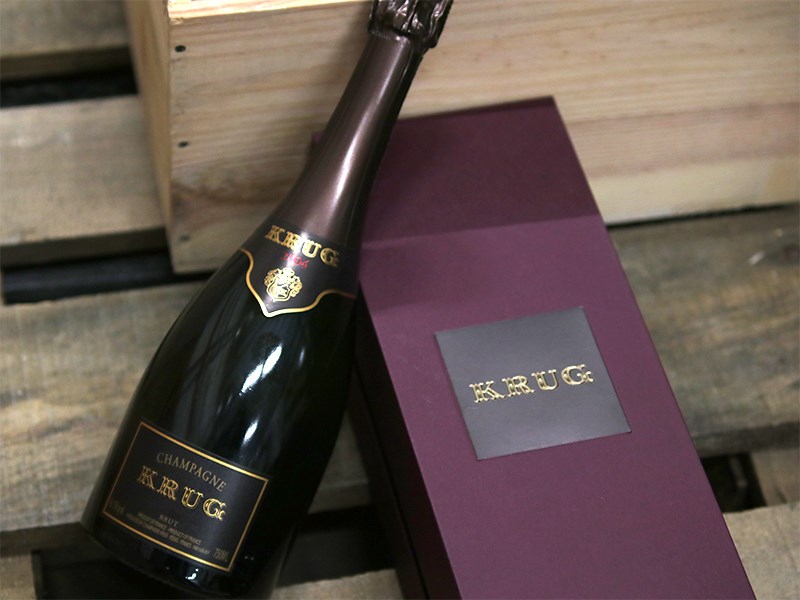
The Different Wines From Krug Champagne
”In principle, a good Champagne House ought to make two Champagnes of the same quality. […] Champagne Number 1: this composition should be altered every year to re-create the most generous expression of Champagne. Champagne Number 2: […] the Champagne of circumstances.
- Joseph Krug, Founder of Krug
This principle is the essence of how Krug has been made since the first edition of Grande Cuvée. This wine is still number 1 in the above equation - the others have emerged by chance.
Krug Grande Cuvée MV
Krug's Grande Cuvée MV can be compared to a symphony orchestra. An orchestra composed of the best individuals is conducted to sound perfectly together. The symbiosis. The unit. Rather than the individual. That is the key to understanding this unique Champagne.
"This is the sound of the perfect symphony orchestra"
- Olivier Krug
Krug Grande Cuvée is produced in a new version each year, intended to show the style founded by Joseph Krug in 1843. The wine is released with a new "Edition" number every year. The latest in the series released in 2022 is Edition 169. This Champagne is ready to drink when it comes on the market. However stored for several years, the taste will only be more complete.
Grande Cuvée is a Multi-Vintage composed of more than 120 different base wines from more than 10 vintages. Always based on a given vintage but supplemented with reserve wines from Krug's wine library. A QR code and an ID number are on the back of the bottle. These can be entered on either Krug's website or app, after which the complete composition in each bottle is displayed.
An example is the latest release: 169ème Édition. It is made from the 2013 vintage, representing 60 % of the total wine. In addition, 40 % is blended from older vintages to create the desired balance. There were 146 different wines from 11 other vintages, with the most aged wine being from 2000. Cellar master Julie Cavil has ended up with a grape composition of 43 % Pinot Noir, 30 % Chardonnay, and 22 % Meunier, which is a typical blend of the grapes in Grande Cuvée.
The wine is blended before the base wines become sparkling after the alcoholic fermentation. The wine is then bottled in the classic Krug bottle and aged seven years in the cellar before disgorging. Then the wine is ready for the market.
Read our guide to making Champagne here
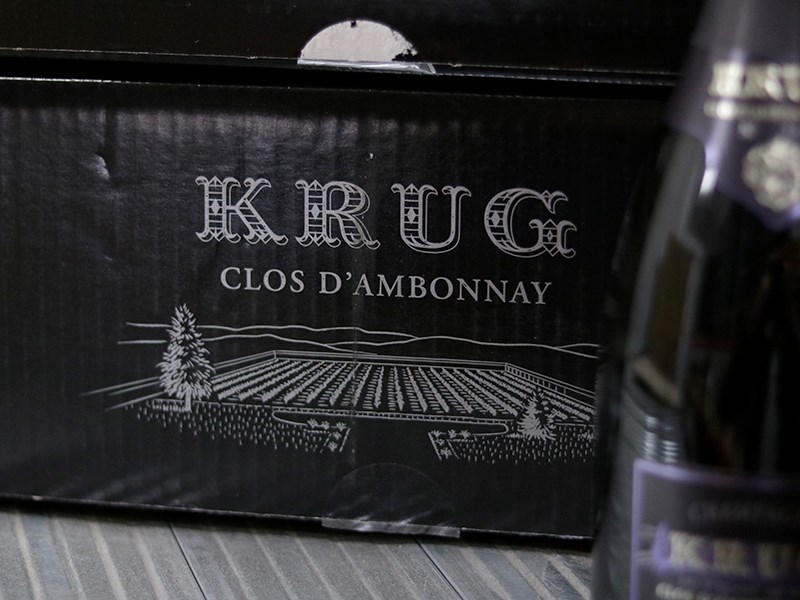
Krug Vintage
Krug Vintage is the sublime expression of the best years. The years when the cellar master finds an expression that justifies being bottled alone. Krug Vintage is when a small part of the symphony orchestra achieves a beautiful balance on its own.
Krug Vintage is still a combination of several factors and lives well from the individual parcels that are vinified separately. The wine is combined from several different grapes harvested in other villages. At Krug, balance is sought, but the vintage must also stand out in the final blend. If this cannot be achieved, the wine is not released.
The latest edition Krug Vintage is from the iconic 2008 vintage, which has set new standards for how good Krug can be at this level. The vintage has been named in several places as one of the best for a long time in Champagne, and at Krug, they obviously do not disagree.
2008 is characterized by a cold growing season, which delivered very heterogeneous grapes. The wine is composed of 53 % Pinot Noir, 25 % Meunier, and 22 % Chardonnay. Before release, the wine aged 12 years in the cellar at Krug.
Krug Vintage is a wine that is helping to set the standard for vintage Champagne. The most incredible experience comes to the patient consumer who saves this until it is over 20 years old.
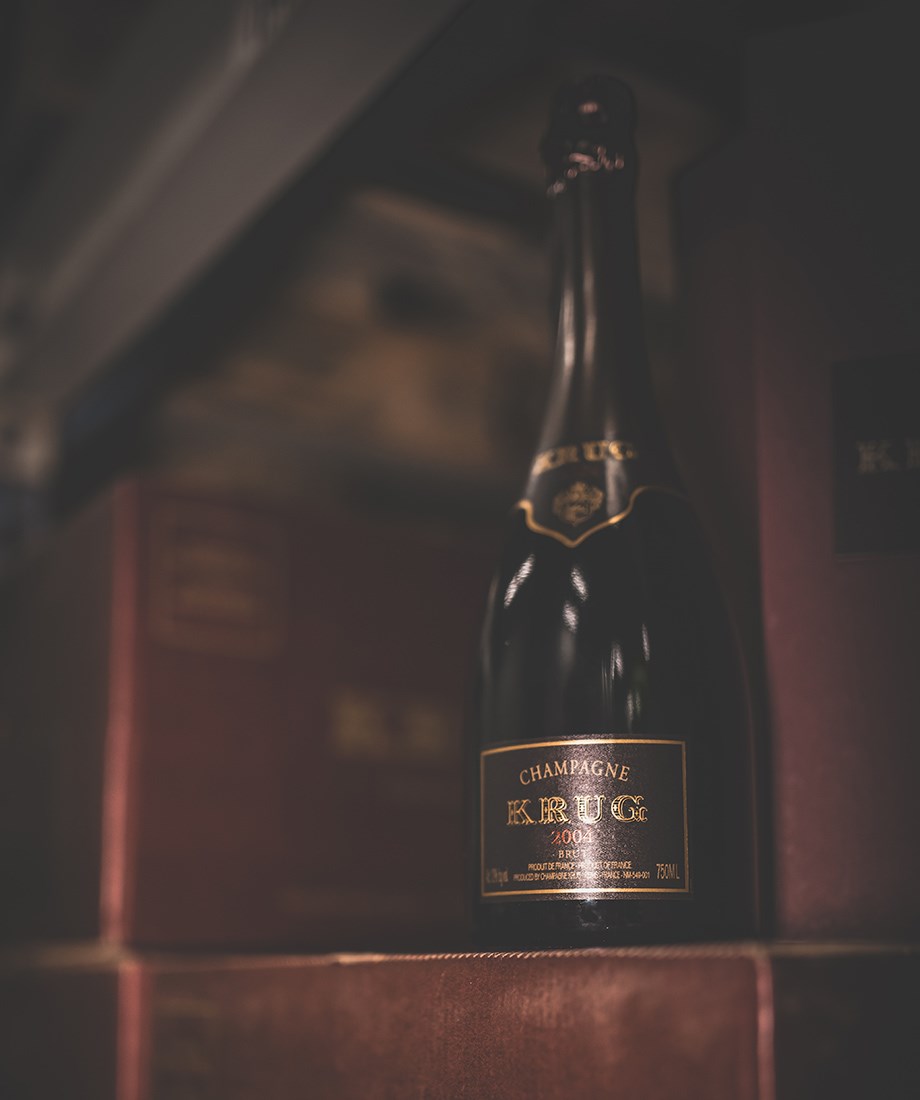
Krug Collection
Krug Collection is the deep production of Krug Vintage, where the wine has got extra layers from more extended aging at Krug.
Imagine 50 artists singing a song, going their separate ways, only to meet 20 years later and sing the same song. It would sound different in every way. This is the musical analogy that cellar master Julie Cavil sets up to explain the Krug Collection best.
The bottles for Krug Collection are stored at Krug and carefully monitored by the family and the cellar master. The most recent release is 1990, which was released before 1988 simply because taste dictates it. This is determined internally to ensure the highest quality for the consumer in the end.
Only very few bottles are stored at Krug to be released as Collection later. They all come numbered with a letter from Olivier Krug, the sixth generation in the house. These wines are perfect when they come on the market but can develop even more nuances with further aging.
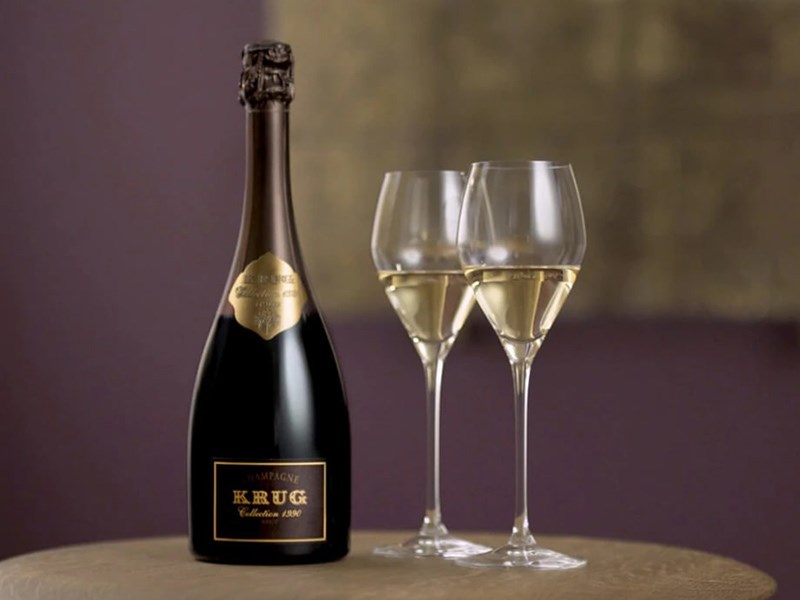
Krug Rosé
Finesse and elegance are at the heart of Krug Rosé. To stay in the beautiful world of the symphony, it is never a question of heavy bass with Krug Rosé - but more subtle notes of violin and cello dominate this blend.
Krug Rosé is the result of the fifth-generations vision. The two brothers Rémi and Henri Krug were often asked why Krug did not have a rosé. So in 1976, they agreed to begin the process of making rosé. It took a few years to refine the process, but in 1983 the first version of Krug rosé was released. From the beginning, it has been the balance and finesse, as well as the unmistakable touch of Krug, that has set this rosé apart from the others. It still is. Krug Rosé gets its beautiful color from red wine added in the last part of the process, which is only allowed in Champagne.
The latest edition Krug Rosé is the 25èmé Édition, which as always is composed of several vintages and wines from different parcels. This edition is composed of 28 different wines from five vintages. 50 % is from the 2013 vintage, and the oldest elements are from the 2008 vintage. Finally, it gets the color with 11 % red wine, which comes from a parcel in Aÿ.
Like the other wines from Krug Champagne, this Rosé can also evolve over several decades under optimal conditions.
Krug Clos du Mesnil
Clos du Mesnil is the violin of the symphony orchestra, but not just any violin. It is the natural first violin that plays so that the hairs on your arms rise. It is simple, clean, and yet with such depth that it can move anyone who takes a sip of the bubbling violin.
The grapes for Clos du Mesnil come from a single vineyard, ideally located in the village of Mesnil-sur-Oger. Krug bought this vineyard from a family in 1971 as part of a larger deal. Until then, the grapes had been used for Champagne Salon.
The vineyard has been enclosed by stone walls since 1698 and planted with Chardonnay for just as long. After the purchase in 1971, the grapes went to Grande Cuvée. Still, after some years of following these grapes, the Krug family realized that this microclimate was optimal for bottling separately.
In 1979, Clos du Mesnil was bottled separately. Krug went against the grain when everyone else was blending and released a highly exclusive wine from a single vineyard - a so-called single-vineyard Champagne. The rest is history. And today, this wine stands as one of the best and most famous in the entire region.
Clos du Mesnil is still made from pure Chardonnay, harvested from the stone-fenced vineyard of just 1.84 hectares. It is only released in the best vintages. The total production from this vineyard amounts to around 12,000 bottles.
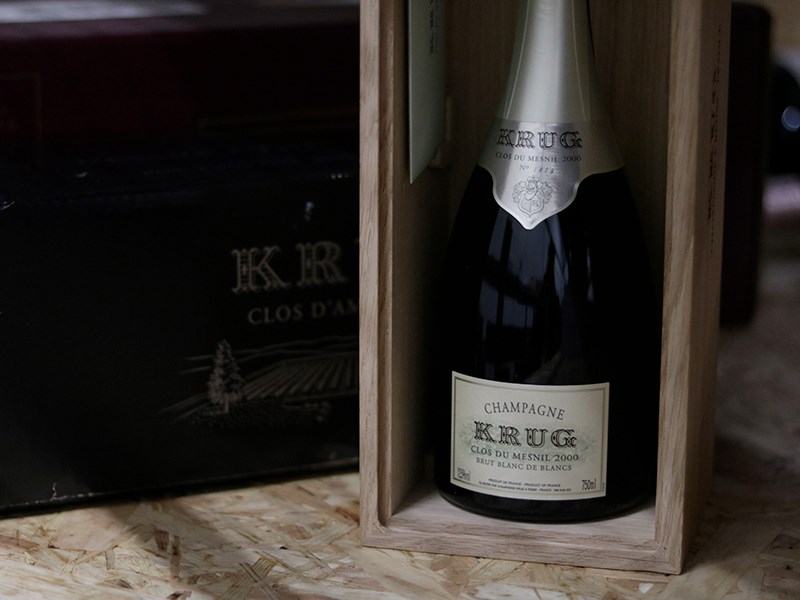
Krug Clos D'Ambonnay
The newest addition to the Krug family is pure pinot noir from a parcel of just 0.68 hectares, located in the village of Ambonnay. To be true to the music analogy, Clos d'Ambonnay can be compared to a slightly larger instrument like a cello, which has more depth and complexity than the violin. This is mainly due to the grape and the place it is grown.
This unique wine is also the rarest of Krug. The wine is currently only released in five vintages: 1995, 1996, 1998, 2000, and 2002. As the production in each vintage is around 5000 bottles, this gives a total of about 25,000 bottles. It does not get any more special or sought after.
For the first several years, the family kept it a secret that they chose to make this wine. So it was an astonishing world market that watched when it first came on the market in 2007. Constantly, the few bottles are snatched away from the market - even despite a high price. And to date, only five vintages have ever been released, making this particular single-vineyard champagne one of the world's most exclusive.
Clos du Mesnil and Clos d'Ambonnay are also called monopoly vineyards, as only Krug produces on these.
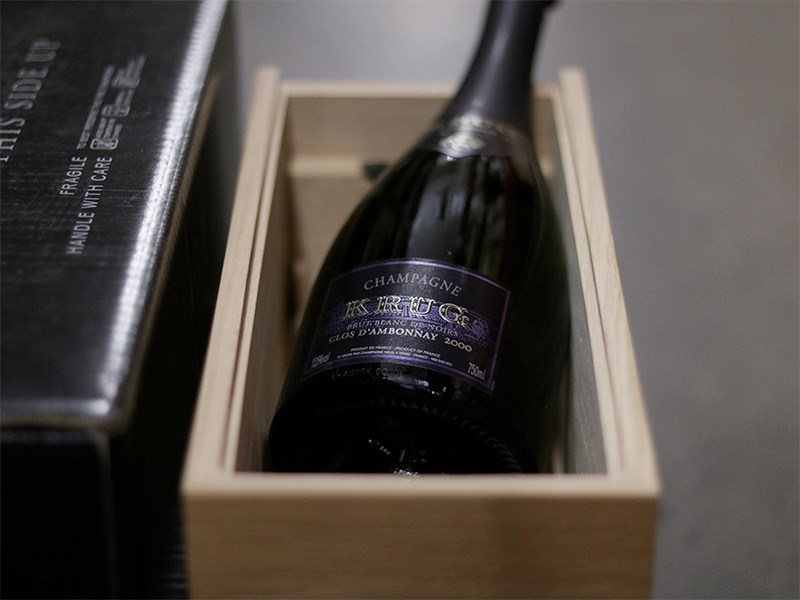
The Future Of Krug
The future is bright for the Krug Champagne house. Olivier Krug is still young and has a good grip on development. Julie Cavil probably has 20 vintages ahead of her as cellar master, so everything is in excellent and safe champagne hands. With LVMH on the team, high quality is guaranteed going forward. The Krug brand is in the shape of one of the world's most giant marketing machines in the luxury segment.
Krug has created a full symphony orchestra that ranks among the world's best champagne houses. And while the orchestra is complete, there is no definitive answer as to whether there is room for new members or whether they have performed at their very best. Only time will tell...
